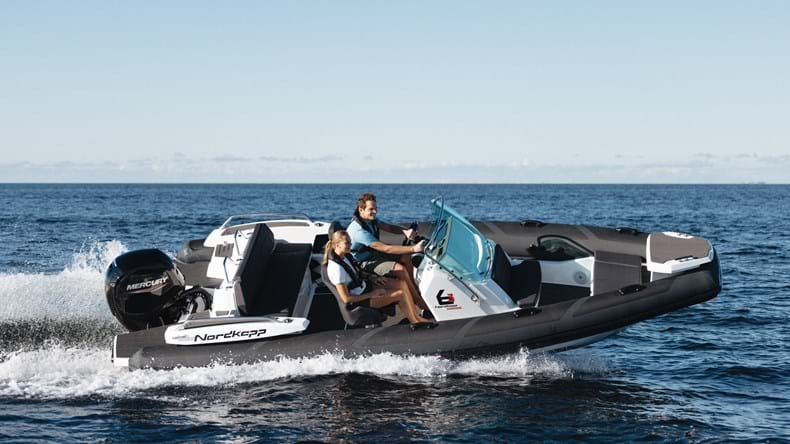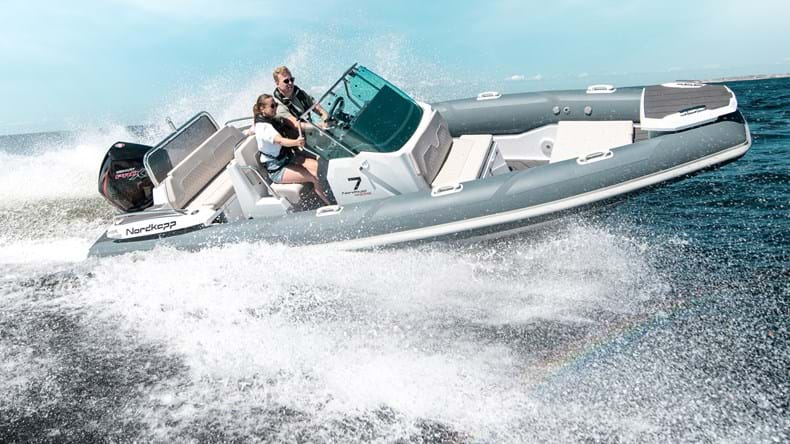För vem passar en RIB?
RIB (Rigid Inflatable Boat) är en båttyp designad för praktiska ändamål och för att ha bra sjöegenskaper. Detta har gjort att den blivit en av de mest populära båttyperna för fritidshus och transportändamål i skärgårdar runt om i världen. RIB:en är typiskt designad med öppna däcksområden för bagage och passagerare, och många av modellerna kan ta emot många passagerare, särskilt inom kategori C.
Om du söker en båt med mindre sannolikhet för skador i hamn eller vid in- och utkörning, eller mindre underhåll, är en RIB vanligtvis ett bra val. När du kör en RIB har du mindre risk för att skada gelcoat, och det är mindre underhåll på RIB-tuberna än vad som vanligtvis krävs för en vanlig glasfiberskrov. Det ger också en något högre flexibilitet när du kör in i hektiska och trånga hamnar, med den mjuka pontonen som skyddar dig.
7 meter RIB. Detta är Airborne 7.
RIB har varit en populär båt kategori i flera decennier. RIB är en förkortning för Rigid Inflatable Boats och är en kombination av ett glasfiberskrov, ett båtdäck (typiskt) och pontoner fyllda med luft. Airborne 7 är en välutrustad RIB som fokuserar på vindskydd, utökad användning under hela båtsäsongen och hög komfortnivå.
Skrovdesignen, funktionaliteten och däckdesignen – detta är vad du kan förvänta dig av en RIB.
RIB är en båt som ofta kännetecknas av sina sportiga köregenskaper och utmärkta hantering i utmanande väderförhållanden.
- Pontonerna: Designen, formen och placeringen av pontonerna påverkar kraftigt hur RIB:en hanterar vattnet. Vissa RIB:ar har större pontoner, placerade lägre, vilket ger stabilitet när båten ligger vid kaj och gör att pontonerna rör vid vattnets yta vid nästan alla hastigheter. Med denna typ av pontoner kan du ha en något kortare underhållscykel, där du rengör pontonerna under båtsäsongen. När det gäller köregenskaperna med detta upplägg kommer du att känna en stadig, bekväm åktur, med mindre lutning vid svängar. Det ger mer en "go-kart-känsla" med g-krafter som verkar mer i sidled. Med pontoner som är placerade högre upp, kommer körupplevelsen vara mer lik en glasfiber mittkonsolbåt. Den kommer att luta mer, med g-krafter som verkar mer nedåt. Dessa pontoner kräver vanligtvis mindre underhåll under säsongen eftersom de främst är ovanför vattenlinjen.
- Förvaringsutrymmen och däcksyta: I de flesta RIB:ar är förarkonsolen placerad i båtens centrum eller något till styrbord. Den låga fribordet gör det enkelt att passera både på babord och styrbord sida. RIB:en används ofta i fint väder, och alla dynor är ute och på plats, men ett bra tips är att kolla förvaringen för alla dynor. Gå igenom förvaringsutrymmena och se hur dynorna passar för förvaring. Vissa RIB:ar har även sprayhood/kapell eller ett hamnkapell, där du även kan förvara dynor.
- Hastighet: De större RIB:arna (6,5 meter och uppåt) med större motorer kan ofta nå hastigheter runt 50 knop. Det är viktigt att komma ihåg att RIB:en, med sitt låga fribord och pontondesign (som diskuterats tidigare i denna text), ger olika köregenskaper än en mittkonsolbåt. Särskilt vid högre hastigheter. RIB:en ses fortfarande av många som en mycket stabil båttyp vid högre hastigheter, tack vare kontakten med pontonerna och vattnet.
Den praktiska RIB:en – enkel hantering som ger bekymmersfri båtliv.
Utrustning och standarder för en RIB – vad bör du betona?
Vindruta och kapellösningar
RIB:ar används över hela världen, med olika behov av vindskydd. För varmare klimat är lägre vindrutor som ger luftflöde populära, medan större vindrutor är vanliga i områden med kallare klimat. Traditionellt har vindrutan på RIB:ar varit mindre än på glasfibermittkonsolbåtar, men senare utveckling av RIB:ar har förändrat detta något. Du bör fråga dig själv vilket typ av klimat du kommer använda båten i, hur lång din båtsäsong är och hur du kommer att använda båten. Genom att göra detta kan du skriva ner några kriterier för din RIB. Ett bra råd är att prova olika körpositioner för att se hur vindrutan täcker dig när du sitter.
Om du planerar att använda din RIB under hela året kan ett sprayhood och kapell vara en bra investering. Detta gör det möjligt att skydda dig från tuffa förhållanden som vind, regn och vågor och håller dig torr och varm under hårdare väderförhållanden. Sprayhooden är vanligtvis mycket enkel att montera, men ett bra råd är att testa den under lugna förhållanden för att lära känna lösningen på din båt.
Praktisk design, smarta funktioner och däckyta
När du undersöker de praktiska detaljerna för en RIB är det vanligtvis klokt att tänka på hur du själv kommer att använda båten. Nedan följer några punkter som kan vara bra att gå igenom:
- Transport av människor och bagage: RIB:en är designad och skapad för att transportera människor och bagage på ett effektivt och säkert sätt. Kontrollera hur förvaringsutrymmena och funktionerna uppfyller dina krav.
- Däcksyta: Ta en närmare titt på däcksyta och hur den är designad. Se till att du är nöjd med hur den passar dina användningsbehov och kriterier. Är det lätt att röra sig runt på däck? Kan du enkelt röra dig från fören till aktern, och har du tillräckligt med förvaringsutrymme för bagage? Passar dynorna i förvaringsutrymmena?
- Förvaringsutrymmen: Hur många förvaringsutrymmen har båten och var är de placerade? Är de helt torra hela tiden (detta är viktigt att tänka på när du förvarar självuppblåsande flytvästar)?












